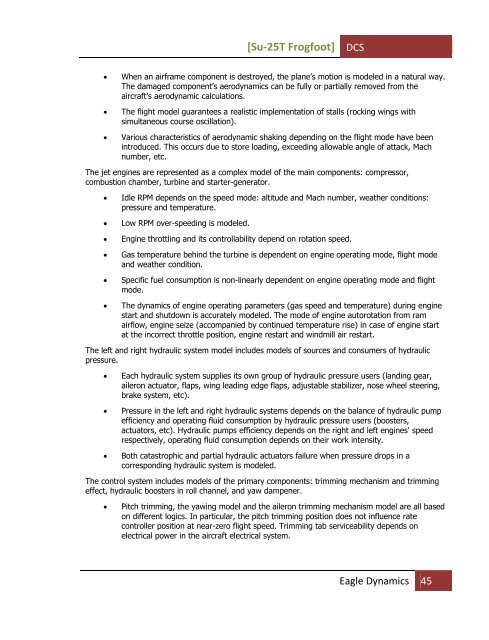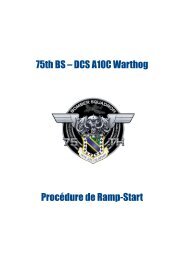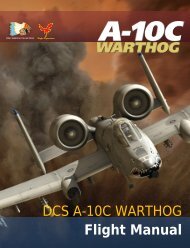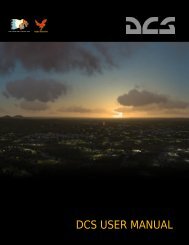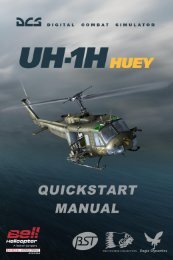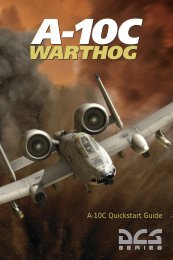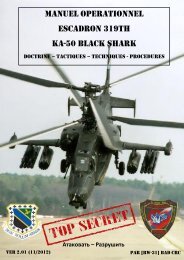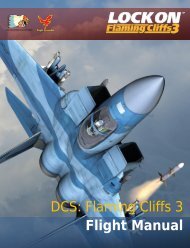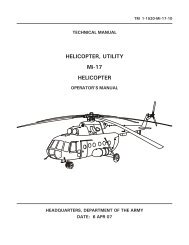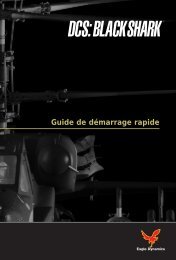Create successful ePaper yourself
Turn your PDF publications into a flip-book with our unique Google optimized e-Paper software.
[<strong>Su</strong>-<strong>25T</strong> Frogfoot]<br />
<strong>DCS</strong><br />
<br />
<br />
<br />
When an airframe component is destroyed, the plane’s motion is modeled in a natural way.<br />
The damaged component’s aerodynamics can be fully or partially removed from the<br />
aircraft’s aerodynamic calculations.<br />
The flight model guarantees a realistic implementation of stalls (rocking wings with<br />
simultaneous course oscillation).<br />
Various characteristics of aerodynamic shaking depending on the flight mode have been<br />
introduced. This occurs due to store loading, exceeding allowable angle of attack, Mach<br />
number, etc.<br />
The jet engines are represented as a complex model of the main components: compressor,<br />
combustion chamber, turbine and starter-generator.<br />
<br />
<br />
<br />
<br />
<br />
<br />
Idle RPM depends on the speed mode: altitude and Mach number, weather conditions:<br />
pressure and temperature.<br />
Low RPM over-speeding is modeled.<br />
Engine throttling and its controllability depend on rotation speed.<br />
Gas temperature behind the turbine is dependent on engine operating mode, flight mode<br />
and weather condition.<br />
Specific fuel consumption is non-linearly dependent on engine operating mode and flight<br />
mode.<br />
The dynamics of engine operating parameters (gas speed and temperature) during engine<br />
start and shutdown is accurately modeled. The mode of engine autorotation from ram<br />
airflow, engine seize (accompanied by continued temperature rise) in case of engine start<br />
at the incorrect throttle position, engine restart and windmill air restart.<br />
The left and right hydraulic system model includes models of sources and consumers of hydraulic<br />
pressure.<br />
<br />
<br />
<br />
Each hydraulic system supplies its own group of hydraulic pressure users (landing gear,<br />
aileron actuator, flaps, wing leading edge flaps, adjustable stabilizer, nose wheel steering,<br />
brake system, etc).<br />
Pressure in the left and right hydraulic systems depends on the balance of hydraulic pump<br />
efficiency and operating fluid consumption by hydraulic pressure users (boosters,<br />
actuators, etc). Hydraulic pumps efficiency depends on the right and left engines' speed<br />
respectively, operating fluid consumption depends on their work intensity.<br />
Both catastrophic and partial hydraulic actuators failure when pressure drops in a<br />
corresponding hydraulic system is modeled.<br />
The control system includes models of the primary components: trimming mechanism and trimming<br />
effect, hydraulic boosters in roll channel, and yaw dampener.<br />
<br />
Pitch trimming, the yawing model and the aileron trimming mechanism model are all based<br />
on different logics. In particular, the pitch trimming position does not influence rate<br />
controller position at near-zero flight speed. Trimming tab serviceability depends on<br />
electrical power in the aircraft electrical system.<br />
Eagle Dynamics 45


